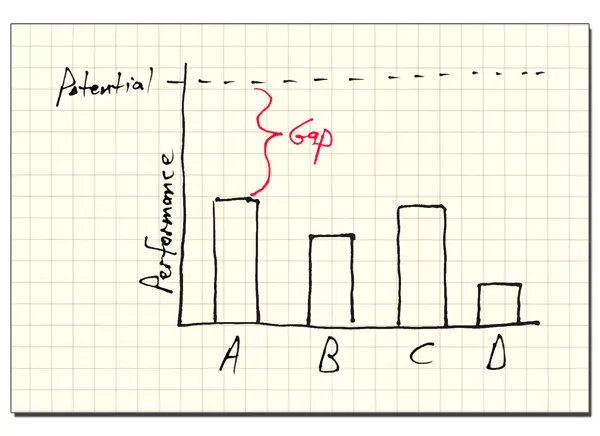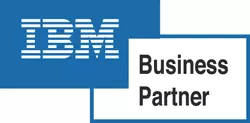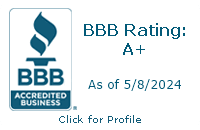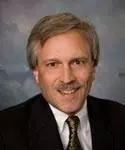
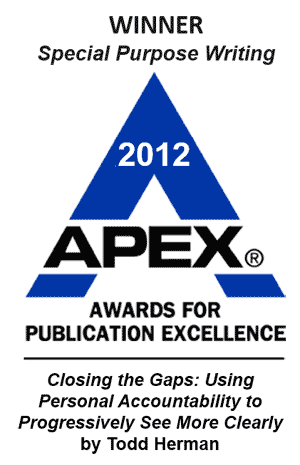
I recently recalled a Maximum Impact lesson by John Maxwell, where he said – "Your blind spots come from your strengths." The thinking behind this is you assume that others have your same strengths – yet, they do not. John listed his top five strengths, as assessed using the StrengthsFinder.com web site, and then explained both his finer points and blind spot in each strength.
In October 2001, my good friend, Abby Donnelly, introduced me to the StrengthsFinder assessment. I bought a book having an access code, took the assessment, and was amazed at the accuracy of the assessment ... except possibly my fifth strength. My signature strengths are – Achiever (John Maxwell and I share this as our top strength), Learner, Focus, Strategic (he and I share this as our fourth strength), and Significance.
I did not especially like the assessment's description of Significance, which begins "You want to be very significant in the eyes of other people. In the truest sense of the word you want to be recognized. You want to be heard. You want to stand out. You want to be known." Sounds like someone who is a hot dog or a showboat, and I considered myself neither. The reason I did not initially like this strength? I was focused on the "blind spot" of the Significance theme. Yes, taken to extremes, Significance leads a person to seek being the center of attention, to have a big head, and to be arrogant. What I failed to recognize is the many benefits Significance can have in helping improve performance.
Because I had not yet realized my need for personal development, I filed these results away and went on.
To help illustrate the concepts described in this newsletter, I doodled a few "charts." The first one is shown below. Don't read anything significant into the specific height of, or changes in, the bars, or even in between particular areas – nothing scientific or specific at all. These charts are just what I happened to draw at the time.
Gap 1: Leading Myself – Coaching
In early 2004, I realized I needed to make some changes in my business – and I (somewhat reluctantly) concluded the only way I could change my business was to change me. So I engaged a coach and began the journey I would ultimately call "Intentional Reality" – a process for turning intentions into reality by assessing the situation accurately, devising appropriate steps to achieve the desired outcome, taking action, evaluating results, and repeating the cycle as many times as needed. By the way, my coach made me do something rather annoying – I had to accept complete responsibility for the results I achieved, whether I liked them or not.
I was not getting the results I wanted, because my blind spots interfered to keep my performance below its potential. For a person having Achiever as the top strength, this is frustrating – yet, Significance kept me from admitting the reality of things. Fortunately, my coach was persistent and we eventually pried loose the grip of Significance to allow me to clearly see reality. Once we did this, improvements in my self-leadership quickly followed, and I was able to make the necessary changes to my business.
After those changes were made, I continued with coaching because I was intrigued about "what's next" and how much further my performance could be developed. Along the way, I found the process of self-development to be quite interesting, and frequently identified books and articles to help me better understand the concepts and science behind personal growth.
Many years later, I would learn the "equation" for the gap I was addressing through coaching:

Performance Self = Potential Self – Interference Self
You can rearrange the equation's components to get this:

Interference Self = Potential Self – Performance Self
In the doodles, I've used the word "gap" instead of "interference" because it's shorter. I see a slight difference in the terms:
- "Gap" tends to raise a WHY question, which is typically judgmental or subjective – "WHY does this gap exist?"
- "Interference" tends to raise a WHAT question, which is typically matter-of-fact or objective – "WHAT steps can be taken to reduce interference and improve performance?"
To me, "interference" results in a "gap" to be addressed. And the reason "interference" is not always addressed is it results from one's blind spots. And the way to cure a blind spot? Bring in an objective viewpoint, such as that provided by a coach.
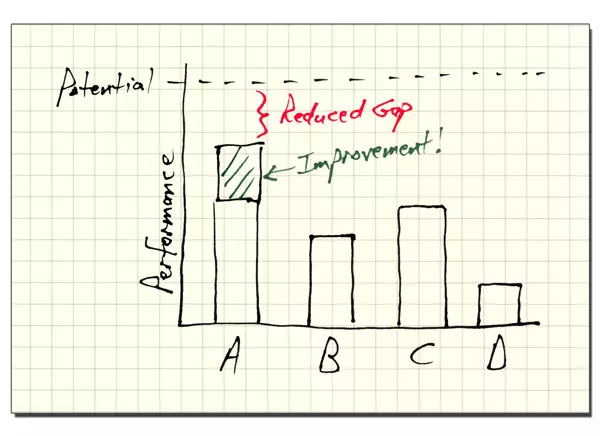
Gap 2: Leading Others – "Todd's Results" Accountability Team
A few years later, I realized I needed to make wider changes – my firm's performance had plateaued, and I needed to better lead my people in achieving better results. Thus, in 2006, I formed what is called the "Todd's Results" team, consisting of two accountability partners (my coach and one other person), to help me plan and execute specific tasks I need to accomplish in each of three areas during a month. Our first meeting was in January 2006, and it was to plan tasks for the upcoming month. At our second and all following meetings, the agenda has always been the same – evaluate whether or not I had met the agreed-upon goals set at the start of the month, discuss issues anticipated in the upcoming month, and set SMART (Specific, Measurable, Achievable, Relevant, and Time-Bound) goals for the following month.
To keep things interesting, I committed to give my accountability partners complete authority to assess my performance as either "Yes – Met" or "No – Not Met" and then to publicly publish their joint assessment on my web site! Yikes – the possibility of having a "No – Not Met" publicly disclosed has ALWAYS kept Achiever AND Significance on "their" toes!
Thus, the "Todd's Results" team and process helped me close the following gap:

Interference Firm = Potential Firm – Performance Firm
The public publishing of my results on my web site has provided me a VERY strong incentive to consistently meet my agreed-upon goals, month after month after month.
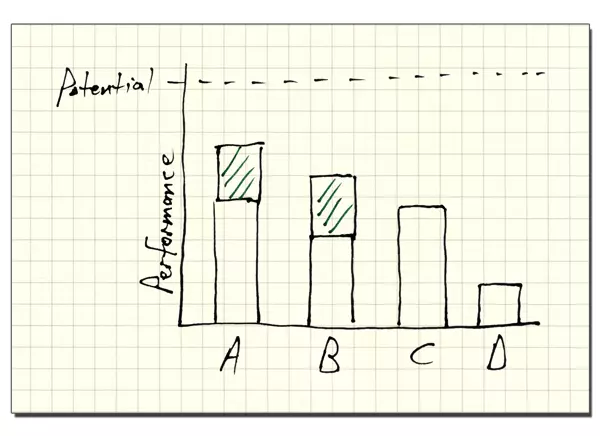
Gap 3: Being Evaluated on My Performance – Truly Independent Process
I am very proud of one thing my firm has always done – even though we're a small firm and it would be easy enough to slough off performance reviews, I early on made "The Rule."
"The Rule – No employee can get a raise without a performance review."
Amazingly, "The Rule" has been very effective in motivating employees to get performance reviews done on a timely basis!
November 1, 1993 was my first employee's first anniversary date! This meant it was time for a raise, and this meant a review was needed. One problem – we didn't have any forms or process for this. So, she and I devised one-page forms – a review form for me to complete on her, a self-review form for her to complete on herself, and a supervisor review form she would complete on me – and a process to do this. This paper-based process proved to be effective for several years, until we revised the review forms and process. While we kept the general process the same, we – for some reason no longer clear to me – decided to increase the level of detail in all the forms, and implement the revised forms in a secure document database.
In case you're wondering – yes, "The Rule" applies to me too, with a caveat. From 1989 to 2000, my firm was a sole proprietorship, so I was not an employee and I did not receive a salary – thus, no review was needed. In 2000, my firm became a corporation and I became an employee, making me subject to "The Rule." From 2000 to 2006, my business partner and I conducted each other's reviews. When my partner left the firm in 2007, I attempted to replace the inherent independence of a partner with the objectivity I believed two trusted employees would bring to the task. While this arrangement did provide some desired benefits, it proved to be increasingly awkward and ineffective.
In 2009, the performance review process for my staff (and myself) had grown clumsy and ineffective. There was widespread desire to improve the:
- Form – Make it shorter, with a goal of one single-sided page.
- Timeliness – Make it more frequent, with the goal being a quarterly review and plan.
- Time Required – Make it faster, with goals of no more than 30 minutes advance preparation by each party, and limiting the meeting to conduct the review and plan to 30 minutes.
- Process – Make it easy and painless, with a goal of making everything "100% complete" in a single meeting.
I worked with an outside consultant to develop the forms and test the process, and then it was time to test all this, so the guinea pig was ... me. To make this "real," however, I needed to OFFICIALLY turn over evaluation of my performance to this consultant. This generated some butterflies in my stomach when I turned things over – the experience, however, turned out well and I have kept this arrangement to this day.
This was the gap being addressed:

Assessment Subjective = Intentions Subjective – Results Objective
A few comments on this equation:
- I have changed the notation to reflect a John Maxwell teaching – he said something like: "We judge ourselves by our intentions, while we judge others by their actions."
- I have used "Assessment" instead of "Gap" – the latter implies something which is always negative, while the former can be positive or negative.
- The reason "Assessment" is Subjective is that I was not completely independent of the process – my "Intentions" are Subjective and always entered the equation.
After putting things in place, the situation became:

Assessment Objective = Plan Objective – Actual Objective
By removing me from the equation, planned versus actual results form the basis for a truly objective assessment.
One comment – assessing Performance versus Potential of ANY type is ALWAYS going to be subjective, no matter who is doing the assessment. Nonetheless, the more objectivity brought to any assessment, the better for clearly seeing reality and plotting a course for improvement.
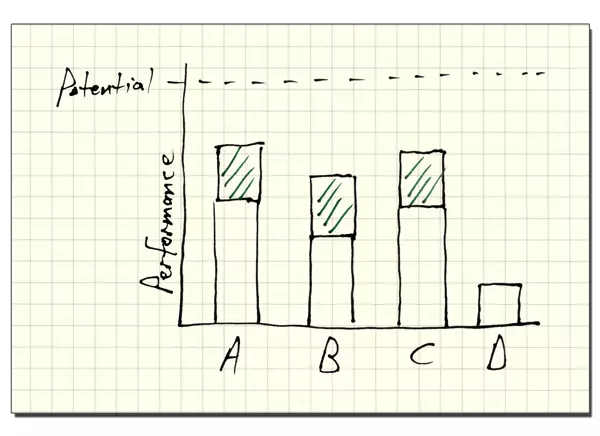
Gap 4: Receiving Feedback on My Leadership – Anonymous Reporting
There was one lingering item from the "legacy" review process to address – the supervisor review. In summer 2011, I asked my "Todd's Results" team to address this issue, and gave them some ideas and resources to consider. They met and decided the focus should be on my leadership qualities, and we then determined a pool of possible attributes. Using a very creative activity at our September 2011 Firm Meeting, my coach used a "sorting exercise" with each staff member to determine what attributes were most important to each, and then summarized the results to find a natural dividing line at 20 items. Adding in one other attribute to ensure coverage of a desired area, and then adding several open-ended questions, the new Leadership Review Questionnaire (LRQ) process – revised to guarantee anonymity and to be conducted twice a year – was described at our November 2011 Firm Meeting, and then tested with the staff at the same meeting.
The LRQ will help my coach plan areas of development, and the outside consultant more objectively assess my performance. This form and process addressed another gap.
With the previous form and process, here was the situation:

Assessment Subjective = Leadership Potential – Feedback Face-to-Face
With the face-to-face feedback, there was always the potential to "taint" the results because – just as in Gap 3 – I was in the equation.
With the new form and process, we now have this:

Assessment Objective = Leadership Potential – Feedback Anonymous
The result? A more objective reporting of leadership characteristics.
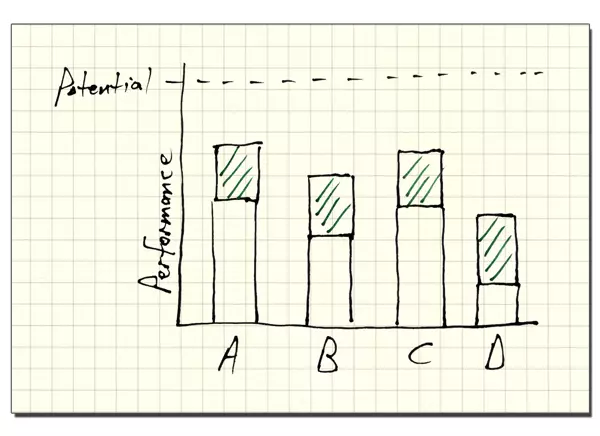
"Measuring" Potential
You may be thinking, "What is my potential? How can I measure it? Do I actually know what that looks like?" Measuring performance versus potential can be done by various objective, statistically validated assessments on the market – or subjectively. Regardless of how it's assessed, one thing I have always heard is human development potential is virtually unlimited. There's always the challenge of moving a "Personal Best" (PB) up a notch, setting a new PB, devising and carrying out plans to reach that, and so on.
Where does all this stop? Who knows...but the achievement of one PB validates the growth and development activities being done, and also sets up the potential for a new PB. This cycle brings to mind another John Maxwell quote – "Leadership isn't developed in a day, but it is developed daily." How very true! And, you can replace "Leadership" with any other attribute, and still have a true statement.
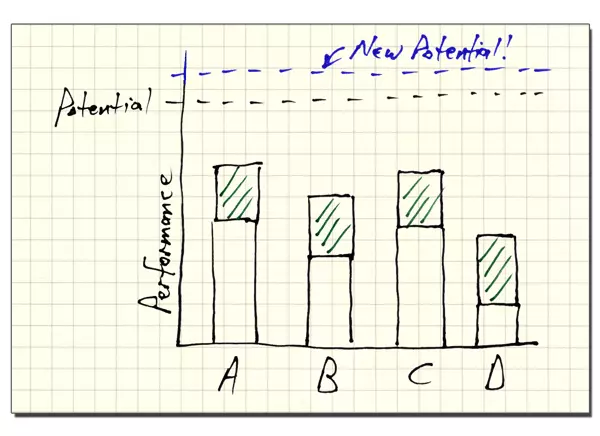
Thoughts on All This
What I've described may seem like a lot of time and effort – in reality, it's not, because this is a summary of a number of small special projects taken over two decades. I see these cumulative small steps being the natural progression of my ongoing journey to turn my intentions into my reality. To do so, I know I must constantly stretch myself, while still being aware of the blind spots inherent in my strengths – in particular, the potential to delude myself resulting from my Significance strength.
As I better develop and use my strengths, my performance and that of those around me increases – yet, stronger strengths also bring the potential for bigger blind spots. If unchecked, those bigger blind spots increase the interference between potential and actual performance. This is especially important in a small business, since most lack an independent Board of Directors which – when functioning as intended – would help keep large blind spots in check.
Remember the annoying thing about personal accountability – I have to accept complete responsibility for the results I achieve, whether I like them or not. Since I truly want to minimize interference, I need to honestly address potential blind spots, and I have done so by creating several small, yet effective, checks and balances. Yes, these checks and balances mean I have to:
- Be completely honest with my coach.
- Document and report my results to my accountability team.
- Turn over my performance assessment to an outsider, and
- No longer know how specific firm members assess my leadership.
Putting these checks and balances in place required me to give up control of certain aspects in my work life – and sometimes I receive a comment or assessment I would prefer to NOT hear or see. Nonetheless, my occasional discomfort has been a small price to pay, since I have progressively come to see things more clearly, and progressively grow as a result. To paraphrase John Maxwell, "Clarity and growth aren't developed in a day, but they are developed daily." Improved clarity enables me to grow and shrink performance gaps, helping me more fully practice Personal Accountability and more quickly achieve my Intentional Reality.
![]()
Todd L. Herman



